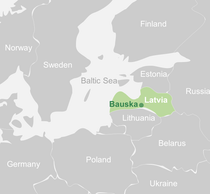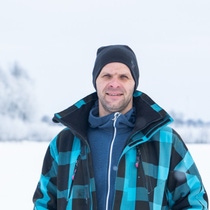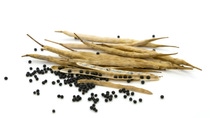“It’s not just about my income, it’s about the resources that go into producing food.”
Uvis Slakteris
Oilseed rape farmer in Latvia
Reduction of Food Loss
Helping farmers to do the Biggest job on Earth

Agriculture
Up to 40% of the food produced in the world never ends up on a plate*. You might think this mainly comes from cucumbers getting soft and moldy in the depths of your refrigerator. But for farmers, who are doing the biggest job on earth, food loss can happen in their fields as well. And it’s not only the loss of their crops but all the water, fuel, emissions, and other resources it took them to grow food that will never be eaten.
Uvis Slakteris farms near Bauska in southern Latvia, not far from the Lithuanian border – a region he describes as the breadbasket of his country. The climate is cool and damp, in some regions, snow is a regular occurrence, and winter temperatures can drop to below minus 25 degrees Celsius. Oilseed rape is an important crop on his 1,700-hectare farm, which he sells to companies that process and export the crop for use as cooking oil or animal feed. His livelihood depends on getting the most yield out of his oilseed crop and preventing loss in the face of weather extremes, and threats from pests and diseases.
Bauska is located 66 km from the Latvian capital Riga. About 80% of Bauska municipality territory is agricultural land and 13% is forested.
“It’s not just about my income, it’s about the resources that go into producing food.”
Uvis Slakteris
Oilseed rape farmer in Latvia
Food loss takes place between production and distribution, while food waste takes place mainly at the consumer level, in the retail and food service sectors. Food waste leads to the unnecessary consumption of resources like land, water, energy, and inputs, and contributes to increased greenhouse gas emissions. (Source: FAO)
Crop loss, like the kind Uvis works to reduce, significantly contributes to waste in the food supply. The resources used to produce food that never ends up on a plate equate to 8% of the total global emissions, about 3.3 billion tons of CO2. That is at least four times those of the aviation industry*. Plus, crop loss and food waste also mean wasted inputs – like fertilizer and water – applied to grow that food. The World Wildlife Fund estimates this water loss at 250 trillion liters annually**.
up to 25%
yield loss
due to pre-harvest pod shatter***
Plant breeders and farmers are working together to minimize crop loss and its contributions to overall resources wasted in the food supply chain. For oilseed farmers in Canada, a BASF solution has been available for a decade already.
A certain feature of oilseed rape pods makes them particularly susceptible to contributing to the world’s food loss problem. The plants develop long, thin pods packed with small oil seeds. When the pods are ripe, they become brittle and they can shatter, opening along the thin seam that runs their length. When they shatter, the seeds fall to the ground where they can’t be harvested by a combine harvester and are wasted after a season-long investment into their growth.
Each yellow flower on a canola or oilseed rape plant develops into a slender pod full of 15 to 40 oil-containing seeds (Source: Canola Council of Canada). When ripe, the seedpod pops open and releases the seeds, in a phenomenon known as pod shatter. If the canola or oilseed rape pods shatter in the field and not in the harvester, the losses can be severe, in particular, during summer rain, wind, and hailstorms.
BASF scientists altered the gene responsible for seam formation within the seedpod, using conventional techniques without any transgenetic modification. Without the seam, the pod resists popping open before the farmer harvests, preserving the oil seed to be harvested in the combine. This patented trait is available in InVigor® hybrid oilseed brand varieties, known as canola in Canada and the US. North American canola growers have had access to this great technology for several years, with InVigor celebrating 10 years this coming season with the pod shatter reduction trait.
"Now it’s Europe’s turn to benefit from this crop loss technology. With breeding efforts tailored to Europe, the pod shatter reduction trait is expected to be available in the coming years through InVigor hybrid seeds,” says Gustavo Palerosi Carneiro, Senior Vice President, BASF Agricultural Solutions, EMEA & CIS.
“Breeding efforts will make pod shatter reduction available in Europe.”
Gustavo Palerosi
SVP Europe Agricultural Solutions EMEA & CIS
For Uvis, the seed that he chooses to plant has a big impact on his final yield, and how resilient his crop is to challenging weather conditions, pests, and diseases. He’s looking forward to having the pod shatter reduction trait in the InVigor oilseed rape seed that already brings him so much peace of mind. “What I trust from these varieties are reliable yield, good winter hardiness, good standability, and resistance to the main diseases – like Verticillium wilt, light leaf spot – which all contribute to crop loss,” he says.
“For Baltic growers, pod shatter reduction will help them manage their workload and prevent losses from other crops on their farms at an intense time of harvesting and replanting for the following season,” says Ingrida Grantina, a Baltic agronomist working for BASF’s Agricultural Solutions division. “When farmers like Uvis know that their oilseed rape pods are protected, they can harvest their wheat first, which, if left longer, can lose its quality and value. With good technical innovations in the InVigor portfolio to de-risk the impact of crop losses from weather, we can help our customers achieve their yield potential.”
“Pod shatter reduction will help Baltic farmers manage their workload and prevent losses from other crops.”
Ingrida Grantina
Agronomist, BASF Agricultural Solutions Latvia
Beyond pod shatter reduction and across crops, breeders are carefully selecting multiple traits that contribute to reducing crop loss in the field. Tomatoes that resist a harvest-decimating virus, soybeans that resist root-eating nematodes. Each additional innovative trait helps farmers grow more food. “It’s about the future of our planet. We need to be more sustainable in agriculture, and that means reducing loss and waste at every stage of the supply chain.” Uvis says. By working together, farmers and plant breeders continue to develop new technologies and practices that make a more sustainable future possible.
Published January 26, 2024
Sources:





